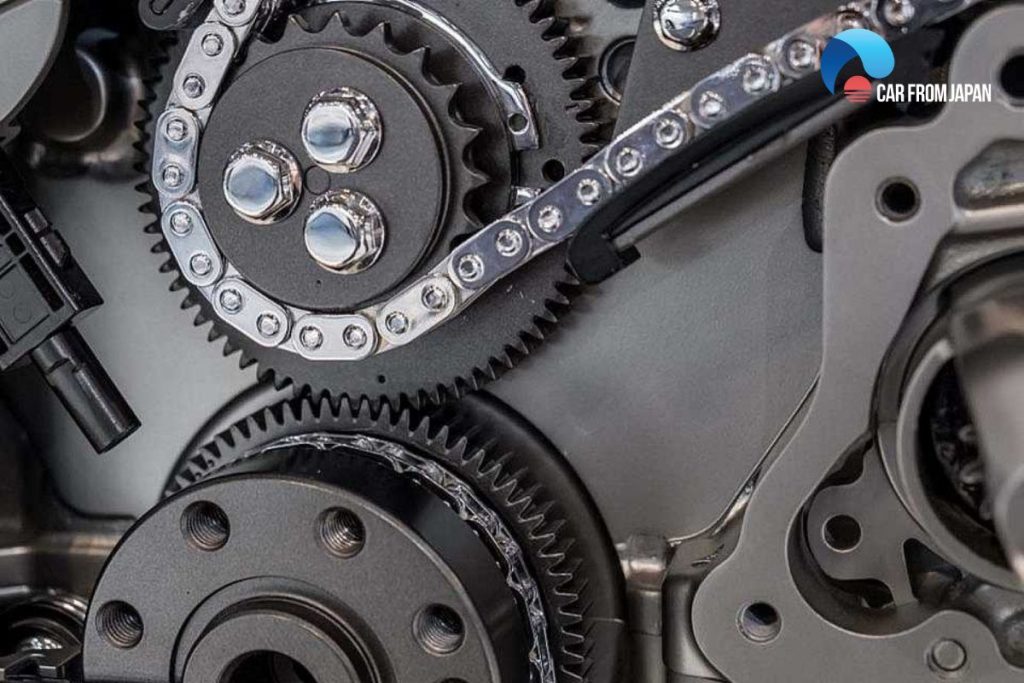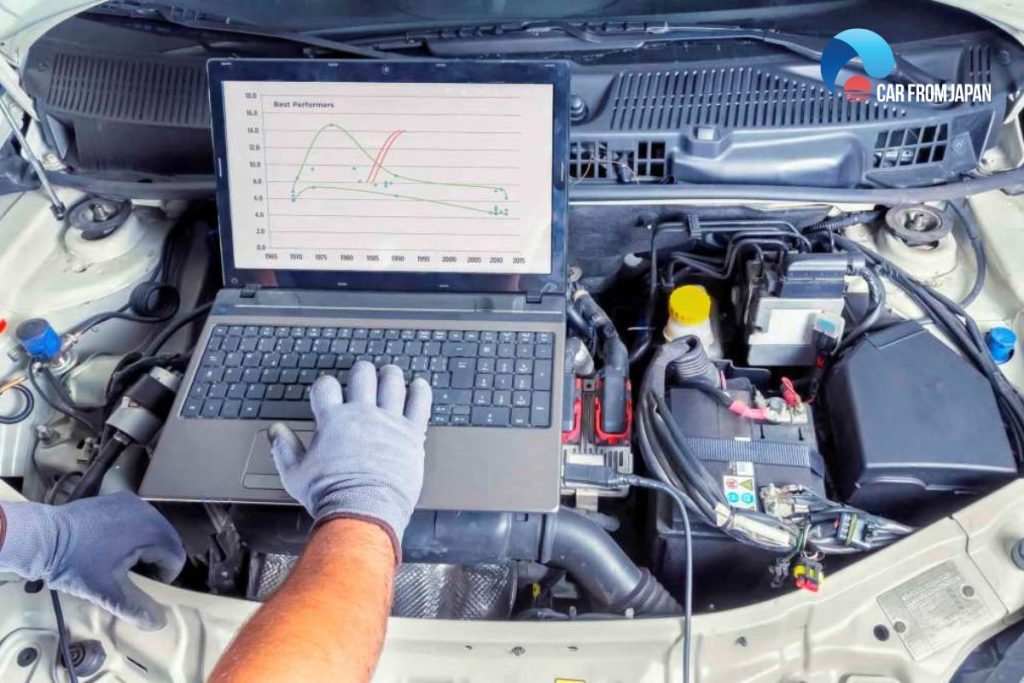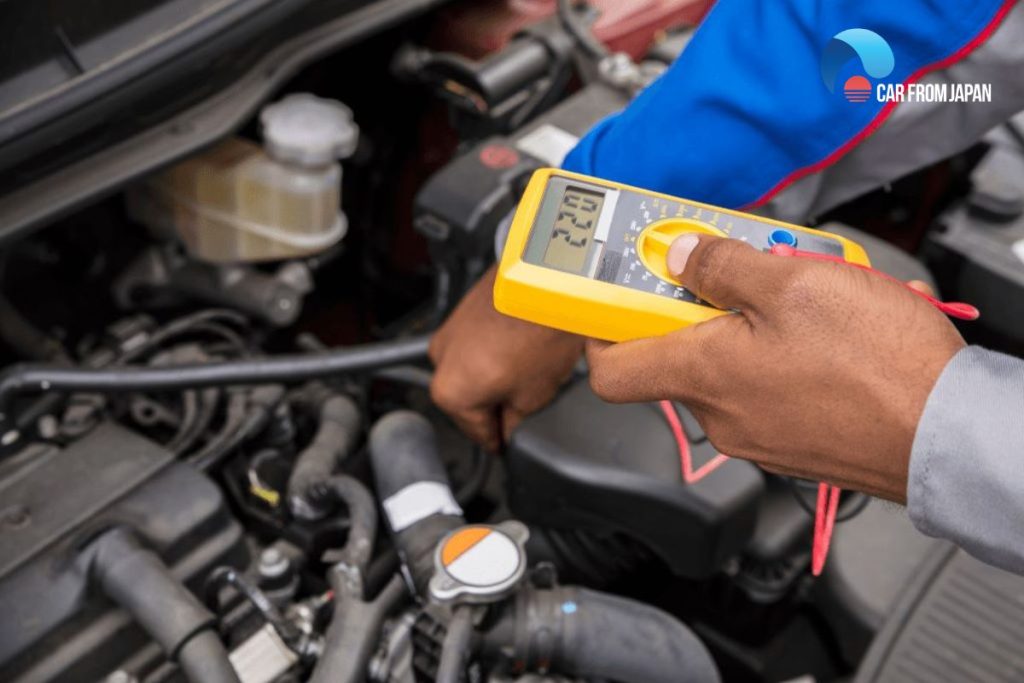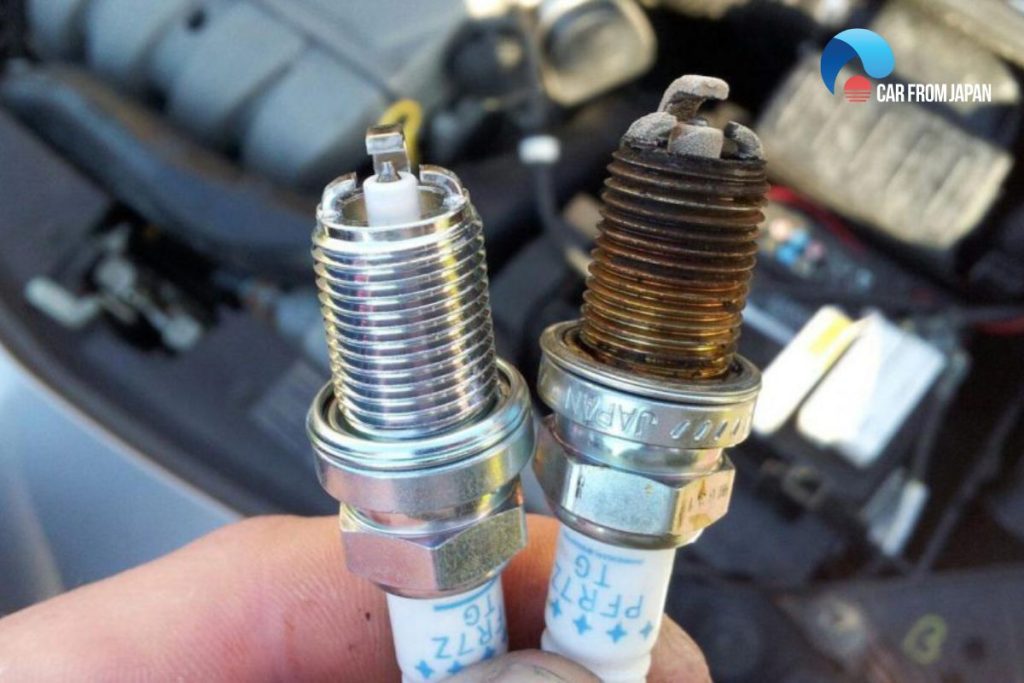Having your car shuts off while driving is a dangerous situation. There are many reasons for this headache.
Learn the most likely culprits for car randomly shuts off, how to fix and avoid it in the future with proper car maintenance, and the steps to follow to keep yourself and others on the road safe.
Contents
7 Reasons Why Your Car Shuts Off While Driving
Faulty Crankshaft Position Sensor
One of the most common reasons for the issue of car turned off while driving is a faulty crankshaft position sensor. The crankshaft position sensor’s role is monitoring the engine’s many moving parts including the crankshaft, engine valves, and pistons.
It tracks the crankshaft’s velocity and location to help facilitate the optimal timing for fuel injection and ignition.
A failing crankshaft position sensor cannot provide the correct information about piston positioning in the engine to the Engine Control Unit, causing a cylinder to misfire.
If the crankshaft position sensor isn’t working properly, it can also cause the check engine light to come on. Another sign of the faulty crankshaft position sensor is the tachometer isn’t working properly.
The tachometer is the gauge typically located next to your speedometer on your dashboard that reads the RPM’s in your car.
It typically increases every time you rev your engine. When the intended speed is achieved, the tachometer will stay put in its place.
If the crankshaft position sensor is faulty, it will send incorrect and abnormal data to the ECU, which is then relayed and causing the tachometer to start working erratically or sporadically.
Other common symptoms of a faulty crankshaft position sensor is lower fuel efficiency and the engine could run very rough, misfire before stalling out completely.

One way to check if your crankshaft position sensor is faulty is by using an OBD scanner and reading the error codes from the ECU. If you receive diagnostic trouble codes between P0335 and P0338, then your crankshaft position sensor is having a problem.
Although an OBD scanner might not help you pinpoint the exact issue, it’s still an excellent tool to narrow down the culprits.
Faulty Engine Control Unit (ECU)
Another source of problem that might lead to car shuts off while driving and an illuminated Check Engine light is a faulty Engine Control Unit (ECU) or engine control module.
The ECU in your car is a computer that collects information from various parts of an internal combustion engine to make sure everything in the whole system is working properly in an optimal and precise manner to maximize efficiency.
A faulty ECU can cause sudden drops in power, fuel efficiency, and spark loss, causing your car to shut off randomly and turn back on. Another common symptom of a faulty ECU is your car stalling and jerking while driving. The check engine light might also light up on your dash.
Unfortunately, testing and inspecting your ECU is not easy. If you want to try troubleshooting yourself, the only thing you can do is to use an OBD scanner to see what diagnostic trouble code you get.
However, the code might still not be clear cut for a failing ECU. Your only option is to take it to a professional mechanic. A mechanic will have the right tools and software to diagnose your ECU.

Bad Alternator
The alternator in your car is in charge of producing a constant stream of electricity from the car’s mechanical energy. It uses this electrical energy to run various electrical parts such as dash lights, dome lights, conditioning unit, stereo,… and to charge the battery.
If for some reason the alternator is not doing its job properly, your car will not get the electrical power it needs, leading to the problem of car shutting off. When this happens, you will get a flashing dash.
It’s important to note that if your battery is functioning properly and can supply power after your alternator dies, your car can still run for a while without an alternator, so you might not realize right away what you’re dealing with.
But your car can only last a short period while running on the battery, as the battery is not designed to provide power to the entire car. Once your battery dies, your car will stall and eventually shut off completely.
If you pay enough attention to how your car runs, you should be able to sense when an alternator is not working properly, that is your car will begin to receive an intermittent amount of power.
Regardless, a basic DIY car maintenance job is a need. Use a multimeter or a voltmeter to test your battery together with your alternator at regular intervals, say every 4-6 months.
To test an alternator, leave the engine running, turn off all lights, including the dashboard, and all accessories like the stereo that may be using electricity. Perform the battery test with the multimeter.
Then, test the alternator to see if it will function properly under heavy usage. Let the engine running at a speed of 2000 RPM. Turn on all accessories, including headlights, interior lights, radio, wipers … and reconnect the voltmeter.
A healthy alternator should produce between 13.1V and 14.6V at regular idle speed. Anything lower than 13.0 signals having it further inspected by a professional.

Empty Fuel Tank But Faulty Fuel Gauge
You might be surprised to learn that thousands of people find their car shuts off while driving due to an empty fuel tank.
While some might be too busy or forgetful to check the fuel level regularly and refill at the earliest opportunity, there are instances where your fuel gauge has gone faulty and does not show the real fuel level in the tank.
One of the common reasons of a faulty gas gauge is due to a sending unit failure. This will typically cause your fuel gauge to get stuck in one position regardless of the fuel level, which is typically at the “F” or “E” mark in most cases.
If you suspect that there is a problem with your fuel gauge or fuel level sensor, try to fill 1 gallon or 4 liters of gasoline to see if your car starts again.
Clogged or Faulty Fuel Pump or Fuel System
If your car stopped while driving but then turns back on suddenly, it can often be due to a bad fuel pump. Your engine needs a precise supply of fuel at a precise time as input for combustion to generate power, and the fuel pump is the part that supplies the engine with the correct amount of fuel.
If the engine does not get the correct fuel amount at the right moments, the motor will shut off. And when this happens, it is very similar to your car running out of gasoline.
The bad news is if you are dealing with a faulty fuel pump, there is no bypass for it. You will have to fix it or replace it.
Another reason could be that your fuel filter got clogged. Overtime, the filter can be clogged by contaminations in old gasoline, messing up the ability to produce power and make your car shutting off.
If your fuel filter is nylon or paper, you should just replace it, which is cheap. If it’s made of metal, you can just clean and reuse it.
Most fuel pumps are installed inside the fuel tank. One quick way to check whether the fuel pump is really the culprit is to give the fuel tank a kick with your foot. If the car starts, there is most likely a problem with your fuel pump.
But do not do it violently with a metal tool as the tank is made of plastic and you would not want to damage it.

Bad Ignition Switch
When you turn the key to start the car, the ignition switch, which is installed behind the ignition lock, gets turned. Inside the ignition switch are many tiny metal plates that can build up rust over time.
When this happens, one of these plates may lose connection, and the whole ignition will get switched off. Or the ignition relay can go bad, and the mechanism which controls the amount of electricity going through them will stop working.
All of these symptoms will cause the engine to shut off abruptly while driving.
Luckily it’s easy to check whether a faulty ignition switch is the reason for your car randomly shuts off. When that happens, check if there are lights on your dashboard.
If the dashboard instrument is dead, a faulty ignition switch is likely. Put your car keys in the ignition again after the car shuts down and try turning them. If this doesn’t start the engine, then you most likely have an ignition failure.
Broken Spark Plugs
A vital component that allows your engine to generate power is the tiny spark plugs. If you have only one faulty spark plug, you can still start your car and drive.
But when more than one spark plugs malfunction, your car may start, but it most likely won’t drive long. Multiple faulty spark plugs will cause your engine to stall and cut off while driving.

Before your engine completely shuts off and leaves you stranded, in most cases, there are other telltale signs that you should look out for, including reduced engine performance, lack of acceleration, engine misfires, and engine knocking.
If you come across these symptoms, it’s easy to locate and inspect bad spark plugs.
Once you can physically see your spark plugs, you can determine their condition. A bad spark plug is one that is blistered from running too hot, or one covered with a substance like oil, fuel or carbon.
The Steps To Follow When Your Car Shuts Off While Driving
Needless to say, having your car stalling while driving might leave you stranded in the middle of nowhere, or become a safety hazard if you’re driving at high speed or on the highway.
Follow the steps below to maintain the safety of yourself as well as other vehicles on the road:
Pull your car over to the side of the road
The very first thing you need to do when your car shuts off while driving is not to panic and guide your car to the side of the road.
Pull over to prevent any vehicles behind crashing into your rear, as cars on the highway often drive at high speed. Note that your car will be losing the ability to brake and steer, but this is your only course of action.
In the case that slowing down your car is too difficult, find a safe place to stop your car, and engage the emergency brake. This will cause an abrupt stop, but it’s a hundred times better than abruptly stalling out in the middle of the road!
Restart your car
Now that your car is safe off the side of the road, check if you can restart your car so that you can at least drive to the nearest auto repair shop.
If you’re lucky and can determine or narrow down the culprit, you might in some cases be able to make your car restart.

Use emergency flashers to alert other drivers
If you can’t restart your vehicle, use emergency flashers to notify other drivers to keep you safe while figuring out the next steps.
Call your emergency number or a roadside assistance service
When a car is stuck on the road and there is no help in sight, it’s best to seek help from an emergency number or a roadside assistance service like AAA, which usually has 24/7 assistance.
Alternatively, the police can also help you contact roadside assistance if you don’t have service or your phone is dead, and they will make sure that your car is safe.
And if you’re a bit lucky, your car might shut off but starts again so that you can get home.
You can use an OBD2 scanner at the earliest opportunity to check for any trouble codes in the engine control unit. Continue the diagnostics of the trouble code if you get any.
Conclusion
So we have wrapped up some reasons why your car shuts off while driving and the steps to follow when encountering this issue.
Overall, this issue is a different matter from when your car shuts off after you stop. This happens when the engine is very sensitive at idle and can be caused by many things.
But the most common reasons are a faulty throttle body or a lean fuel mixture that is causing the idle to drop too low.
Hope this article is helpful to you to some extent. Follow the maintenance tips recommended by your automaker to always keep your car in a great shape!




Have learned a lot! My car has this problem and I think ignition switch or fuel pump.
What can cause a car to lose power while driving?
They told me that mine was probably a Sensor that regulates the fuel flow.
My car has this problem.. while already check the fuel pump, ignition switch, fuel filter also alternator, but it still turns off while driving. or maybe wiring?
my car suddenly turned off earlier today. I was just sitting still waiting to pull out of my apartment complex. It cut right back on and I was able to drive it to work with no issue. What could cause this?
could also be a loose battery connection. if a bump in the road causes a connector to come loose ignition will go off and loss of power will cause the engine to stall. check battery terminals by giving them a wigglle to make sure they are not loose
My car just stops for no reason and starts back on, took it to a certified suzuki mechanic in my country and he said he cleand trottle body and calibrated it but the same day we took it did it again. The problem is it doesn’t do this frequently so you can’t go to a mechanic and show him what’s wrong. The car is a suzuki alto 2009 with only 13000miles on the clock !
Did you ever figure out the problem?
Jus had camshaft sensor relaced.also had oil changed. Riding along to it just cut off but cranked right back up
Hi ,..i was driving ..on highway and my car shutdown….,i though it needed a new battery,got new one…still continue driving ..it shutoff again ,..i flag a guy down,..he shake up the battery ..and restart….start driving again…took it to machine..check it found no fault ,plz help..
EFI relay, in under hood fuse box on my 2008. Car would not turn over, left key in #2 position and tapped relay, it clicked and fuel pump came to life. Car then started right up.
My car suddenly cut off in the middle of an intersection but the radio and windshield wiper was still on. What could be the problem?
My car GWM doesn’t idle in the morning but if u press in accelerate it is just fine until 10 minutes and come to normal ..what could be the problem? And the reftcount gauge is moving up and down what cause this?
I have a 2011 Mazda cx9 I could drive it but it cuts off I could start it back up it comes right on my engine light didn’t come on when this happen you think it’s my fuel pump
Thanks for addressing the reasons behind the unnatural behavior shown by the car in the middle of nowhere. A quick inspection of different components of the car prior to leaving for a destination could be very useful to keep the car in working order. However, such kind of inspections should be carried out by experienced professionals. Such professionals have the ability to identify hidden mechanical abnormalities in the car.
After I wash my car engine with the house pipe while stil engine running the car just stop idling and and the fan was running upnormal ..and it never want to start again.
This is so awesome…you are great team,because I have learn alot from you guys and I am greatfull for your teaching and let us know the signs if my car has a problem. This is super great .
Thanks
Team Jan Japan
Team Jan Japan
You are the first ever car dealers who train us before buy a car and after.
Thanks
Mine was due to ECM monitor basically the computer of my car went bad
I have a problem with my Nissan Np200 1.6i 2014 mordel. My car turns off while am driving it, and then after few minutes when i restart it starts. The proffessionals tried to fix it but they loose.
Hello i have a problem on my toyota aqua their a noise in his gear box automatic can someone help me
Hi there …just want to find out why does my car only work with plug number 1 and 4
And the care don’t have power
Ignition coil might be one of the issues to some cars that functions properly on the first part of the travel and then in the middle of a trip engine suddenly dies.
My ford figo fan is always on and my car stoped over heating, at first it use to go on only when is heating and now is running for ever
I was driving my 2008 nissan altima while driving it shuts off on me everything else staryed on even my cooling fans but I could not accelerate
Hi, there I have Mercedes c class 180 compressor 2005 it was doing it and I changed the fuel pump and filter it was ok for couple of weeks since, now it stoped again and I started emedietly then happened second time and it did not start however after 5 minutes it started on a screen it doesn’t not show any errors so please can you tell me what is the problem?
do you need a hacker , i visited premiumhacks.net and i had everything sorted out
I have a 2009 Nissan Maxima it seems to lose power I replaced the alternator battery and ground cable still seems to be doing the same my mechanic can’t seem to find the problem it’s a push start
Hi i have majda demio 97 yesterday it was breakdown running time what is the reason.
I check fuel is okay . but it is not start now.
Thank you for your post its very educative. I have a skoda Fabia and i observed that when i drive the car for some distance the car goes off in motion and when i turn off the ignition and restart the car, it starts and after a little while this happens again. I would like to know exactly what could be responsible for this situation. Is it electrical and if it is what can i check to verify this? The service center i use have been unable to get to the root of this and its been 2 years now.
My car, a 1913 toyota corolla st wg. has run perfect for years. It suddenly started stopping while driving.
After a few minutes it will start for a little while and I will manage to get off the hwy. My shop uses his computer to find the cause and can come up with nothing! They will test drive it, and find nothing. I got to thinking that maybe something internal about the battery could be bad. If that’s not possible, what else could it be?
Recently I was driving my Pajero model 1998 and it shut itself while I was driving. I had enough fuel, but the other thing it would restart again. I also realised if I didn’t exceed 40km/h, 2.5-3 revs and or hit the brakes, the car would not shut down while driving. So I would like to know the problem with it? Thanks!
I was driving my car and it just lost all power my light stayed on and radio but I lost power .if I waited like 15 minutes it crank right up. Please help.
some times the fuel pump becomes
hot and seizes when it cools down it functions normally
Mine does the same thing, radio stays on, engine light comes on and where the mileage window is a code comes on, I took a picture of it and it was fuzzy I think it started out with AR and then some 3 or 4 numbers after it. I have had a new distributor installed and a new alternator, Its really scary. It basically happens the longer I am driving it, shorter distances very rarely.
2000 dodge caravan dies when i turn left or right!!
Did you check your throttle body?
My 2009 Nissan Pathfinder has been doing this. It did it about a couple of months ago just shut off. Then coming into work it did it again but I floored it and it kept going. Going home it did it again! 🙁 I flooored it again and it worked. Now I am taking it to my mechanic and HOPEFULLY will figure something out. I just don’t need a car payment!
Hi, did you find out what the problem was? My Nissan Murano is doing the same thing and the mechanic doesn’t know what it is. I have had 3 sensors replaced and now they are saying the alternator. I’m sceptical about it as it’s been nearly 2 months without car on and off.
The engine and electrical system of my RAV 4 SUDDENLY STOPS WORKING WHILE DRIVING. WHAT CAN BE THE CAUSE OF THIS PROBLEM.
Sadly the MAIN reason most cars today shut off while driving is they are out of oil!
Long gone are the days when you could go 5,000 miles and never burn a single quart of oil.
ALL today’s engines are designed with weak piston rings and use thin oil so they can easily burn more than a quart of oil every 1,000 miles so after about 2,000 miles your oil will be so low that the engine will shut off without warning because it is too low on oil.
You now MUST pop the hood and check your oil level at least every other tank of gas or you may find yourself looking at $7,000 for a new engine
Hello… My 2001 180,000 miles Chrysler Pacifica stopped on me yesterday while I was driving at 45 miles per hour. Luckily I was able to coast the rest of the way home about .25 miles. The car had jerked earlier that morning while at a stop light as i accelerated off on the green light. But ran okay to my next 4 stops for the next 2 hours until it stopped on the way home. All of the interior lights and radio do come on okay. But when I tried to restart the car the ignition runs but doesn’t catch. There isn’t even any clicking noise to indicate that it may be the battery or alternator. Could it be the starter, ignition switch, spark plugs, fuel pump, dirty fuel filter? I will note that a couple of months ago my car wouldn’t start because I left the radio playing for about 2 hours while I was sitting in the car. I had to get a quick jump. It wouldn’t start again last month when my kids accidentally left the back door open for about 3 or 4 hours. But this time I had no power to the lights or radio come on at all. I got a jump then as well with no problem. I then went to AutoZone to have the battery and alternator checked and they both were fine. Now it will not start but there is power to the lights and radio. The ignition just on turn over, it just runs constantly until I turn the key off. Please Help!!!!!
Hello… My 2001 180,000 miles Chrysler Pacifica stopped on me yesterday while I was driving at 45 miles per hour. Luckily I was able to coast the rest of the way home about .25 miles. The car had jerked earlier that morning while at a stop light as i accelerated off on the green light. But ran okay to my next 4 stops for the next 2 hours until it stopped on the way home. All of the interior lights and radio do come on okay. But when I tried to restart the car the ignition runs but doesn’t catch. There isn’t even any clicking noise to indicate that it may be the battery or alternator. Could it be the starter, ignition switch, spark plugs, fuel pump, dirty fuel filter? I will note that a couple of months ago my car wouldn’t start because I left the radio playing for about 2 hours while I was sitting in the car. I had to get a quick jump. It wouldn’t start again last month when my kids accidentally left the back door open for about 3 or 4 hours. But this time I had no power to the lights or radio come on at all. I got a jump then as well with no problem. I then went to AutoZone to have the battery and alternator checked and they both were fine. Now it will not start but there is power to the lights and radio. The ignition just will not turn over, it just runs constantly until I turn the key off. Please Help!!!!!